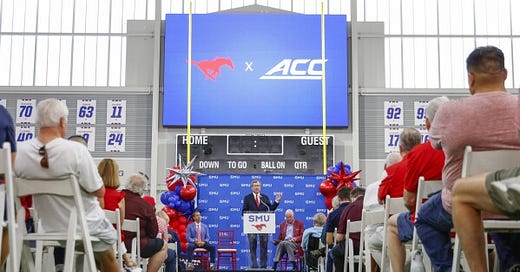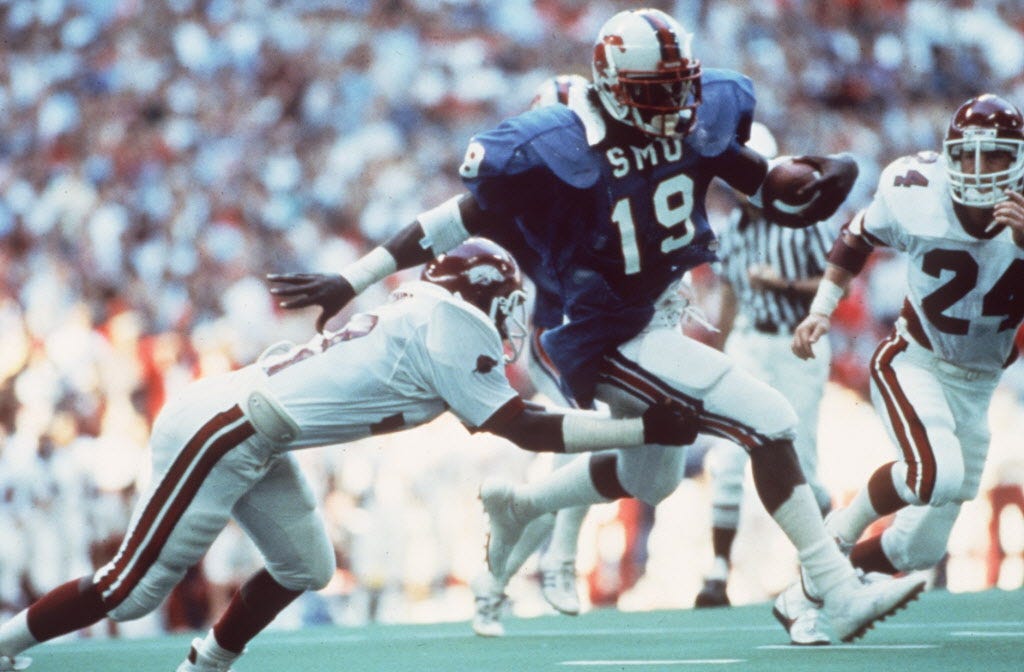Money killed SMU football. Now, it brought it back to life
A school that was given the NCAA death penalty for paying players is now able to forego hundreds of millions to join a major conference
SMU’s 42-16 thrashing of Florida State last Saturday was more than just the latest indignity slapped upon the Seminoles in a month-old season already full of them, though it was also that.
Before the game at Gerald J. Ford Stadium – named after a Texas-based billionaire banker, not the 38th president of the United States (whose middle initial is R, anyway) – SMU legend and Pro Football Hall of Famer Eric Dickerson rode onto the field in a Mustang convertible. George W. Bush, who spends much of his post-presidency life in Dallas these days, performed the ceremonial coin toss.
Sometimes, cliches are that way for a reason – namely, there’s some kernel of truth in them. In this instance, that checks out. Everything is bigger in Texas…even a game against a 1-3 team.
For SMU, though, the matchup with the Seminoles represented something much more meaningful and because of that, no amount of pageantry was spared for a day nearly 40 years in the making.
The game was the Mustangs first ACC contest since joining the conference this past summer, a momentous occasion for a school that even a decade ago couldn’t have possibly foreseen receiving a coveted seat in one of college athletics’ most powerful and influential leagues.
“He talked about we’ve been waiting for this for 30 years, this is how we used to play, and you made us proud,” SMU coach Rhett Lashlee said after the game of the speech Dickerson gave to his players. “It’s hard to put into words in a short answer of all the things that this means to just the SMU family and everyone who’s connected to the university, past, present or will be.”
A football program that was once left for dead – literally – showed that it is very much alive. And the same force that killed it was the same one that ultimately brought it back to a pedestal on which it hadn’t been perched in a generation.
How wealth and greed sank SMU football
In the mid-1970s, SMU had a problem.
In the not-so-distant past, only about 25 years earlier, the Mustangs had been a national power. Across the 1947 and 1948 seasons, they went 18-1-3 and produced a Heisman Trophy winner in Doak Walker.
By the end of the 1975 season, though, they were in a rut. Over a period of 16 seasons, from 1960-75, SMU finished with a winning record just five times. Even those who won elsewhere couldn’t succeed with the Mustangs. Hayden Fry, who went on to become a coaching icon at Iowa and later earned enshrinement into the College Football Hall of Fame, went just 49-66-1 over 11 seasons at SMU and was unceremoniously fired in 1972 (after going 7-4, no less).
The malaise was the fault of some factors outside of SMU’s control, like being the second-smallest school in the old Southwest Conference. Something within the Mustangs’ sphere of influence, though? The ability to recruit better athletes to attend their school and improve their football fortunes.
After the 1975 season, the university hired Ron Meyer (no relation, at least that I know of) to be its next football coach following a successful three-year run at UNLV, which was a Division II program at the time. Following a few lean years – SMU finished below .500 in each of his first four seasons – the 35-year-old Meyer’s suave charm eventually paid off.
His long-awaited breakthrough came in his fifth season, when the Mustangs went 8-4 in 1980, though it ended on a sour note, with a loss to BYU in the Holiday Bowl in which they blew a 20-point lead with just four minutes remaining in one of the most famous and catastrophic collapses in college football history. The following year, they were even better. With the famed “Pony Express” backfield of Dickerson and Craig James running past and through opponents, SMU went 10-1 – a two-point loss against Texas was its lone setback – and finished No. 5 in the final Associated Press poll.
That improvement was reached through a tried-and-true method. The Mustangs paid for what they got.
Why they did so doesn’t require an elaborate explanation. In the 1980s, Dallas was a symbol of prosperity and growth, with the oil and gas industries booming. In offices and boardrooms across the city, alums of schools in the Southwest Conference – a nine-team league with eight members in Texas – would gather to talk about a source of communal passion in Texas: football and, particularly, how their schools fared over the weekend. The Mustangs’ woes over a quarter century brought a certain amount of shame. These people who had achieved great financial and professional success carried the burden of an alma mater with a football program they couldn’t brag about to the Texas Longhorn or Texas A&M Aggie with whom they gathered around a water cooler.
Institutionally, that push to improve the football product and restore some sense of gridiron glory the school once enjoyed was felt.
Aided by some of the sources of vast wealth available to it, SMU built and maintained a slush fund from which it could compensate its players. What began as $20 or $50 payments quickly grew to $500 and escalated to the point where “A Payroll to Meet,” a 1989 book about the SMU’s misdeeds, noted that an assistant for one of the Mustangs staffers was handing out $100 bills to recruits when picking them up from the airport.
That money showed itself in other, more brazen ways.
Keep reading with a 7-day free trial
Subscribe to The Front Porch to keep reading this post and get 7 days of free access to the full post archives.





